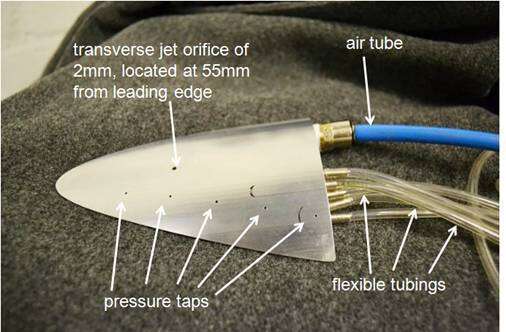The hypersonic waverider vehicle with a high lift-to-drag ratio, L/D, is one of the most promising aerodynamic configurations for future hypersonic vehicles [Huang et al. 2011]. The aerodynamic advantage of the waverider is that the high pressure behind the shockwave under the vehicle does not leak from around the leading edge to the top surface, such that L/D for a waverider is considerably higher than that for a conventional aerodynamic vehicle, which is beneficial for longer cruise durations in the near space. In order to provide forces and moments on a waverider configuration conventional aerosurfaces can be utilised, however at high altitudes the effectiveness of these surfaces degrade due to low density environment. Transverse jet offers a strong alternative. Current investigation focusses on the effectiveness of transverse jets on a waverider configuration. The flow diagnostics include, high-speed schlieren photography at 16 kfps (with 1 μ sec exposure), pressure tappings (at 5 Khz) and 3 component force balance (at 300 Hz).
Figure 1 (top) shows 121 mm long, 92.4 mm wide, 26.1 mm high waverider model with a 2 mm transverse jet orifice located at 55 mm from the leading edge. 5 pressure taps are located off-centred and 8 mm air tube is connected from the base. The pictures below show high speed schlieren visualisation of no-jet case with the cases with jet to freestream momentum flux ratios (J) of 3.48, 5.25 respectively. The average of 1000 schlieren images are presented. The prominent flow structures are depicted on the images clearly, and the detailed discussion of these flow structures can be found in [Erdem and Kontis 2010]. As momentum flux ratio is increased, these structures extend in upstream, downstream and spanwise directions. The bottom plot shows the lift force histories observed with all cases. When the jet is activated before the arrival the main flow a downward force is observed naturally and with the main flow interacting this effect is more pro-nounced, especially for J = 5.25.

Figure 1: Waverider Model
Figure 2: Schlieren visualisation of with annotated flow structures for no jet, J=3.48 and 5.25 respectively
Figure 3: Lift force time histories
References
Huang W., Ma L., Wang Z., Pourkashanian M., Ingham D. B., Luo S., and Lei J.: A Parametric Study on the Aerodynamic Characteristics of a HypersonicWaverider Vehicle. J. Acta Astronautica 69(2011) pp. 135140
Erdem E.and Kontis K.: Numerical and Experimental Investigation of Transverse Injection Flows. J. Shock Waves, DOI 10.1007/s00193-010-0247-1.

